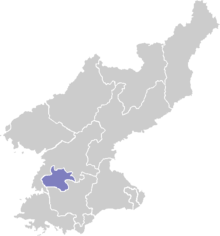Pyongchon-guyok
P'yŏngch'ŏn-guyŏk (P'yŏngch'ŏn District) is one of the 18 guyŏk (political districts or wards) of P'yŏngyang, North Korea. It is bordered by the Taedong River in the south and the Potong River in the north and west, and to the east by Chung-guyŏk, from which it is separated by the yard area of P'yŏngyang railway station. It was established as a guyŏk in October 1960 by the P'yŏngyang City People's Committee through a mandate of the Central Committee of the Workers' Party of Korea.
P'yŏngch'ŏn-guyŏk | |
|---|---|
Guyŏk of Pyongyang | |
| Korean transcription(s) | |
| • Hangul | 평천구역 |
| • Hanja | 平川區域 |
| • Revised Romanization | Pyeongcheon-guyeok |
| • McCune–Reischauer | P'yŏngch'ŏn-guyŏk |
Apartment building in P'yŏngch'ŏn-guyŏk | |
| Country | North Korea |
| Direct-administered city | P'yŏngyang-Chikhalsi |
| Administrative divisions | 11 administrative dong |
Administrative divisions
P'yŏngch'ŏn-guyŏk is divided into eleven administrative districts known as tong. The largest neighborhoods (Ansan, Puksŏng, Haeun, Ryukkyo, P'yŏngch'ŏn, and Saemaŭl) are further divided into two parts for administrative purposes.[1]
| Chosŏn'gŭl | Hancha | |
|---|---|---|
| Ansan-dong | 안산동 | 鞍山洞 |
| Chŏngpy'ŏng-dong | 정평동 | 井平洞 |
| Haeun-dong | 해운동 | 海運洞 |
| Kansŏng-dong | 간성동 | 干城洞 |
| Pongji-dong | 봉지동 | 鳳池洞 |
| Ponghak-tong | 봉학동 | 鳳鶴洞 |
| Pongnam-dong | 봉남동 | 鳳南洞 |
| Puksŏng-dong | 북성동 | 北城洞 |
| P'yŏngch'ŏn-dong | 평천동 | 平川洞 |
| Ryukkyo-dong | 륙교동 | 陸橋洞 |
| Saemaŭl-dong | 새마을동 | 새마을洞 |
Economy
It is probably best known as the location of the P'yŏngyang Thermal Power Plant, in Saemaŭl-dong,[2] which is the electricity source for P'yŏngyang's central neighbourhoods and the surrounding region. Other notable industries in the guyŏk are the Pot'onggang Organic Fertiliser Factory in Chŏngpy'ŏng-dong[3] and the Taedonggang Battery Factory in Saemaŭl-dong.[2]
Education
It is also the location of the Mansudae Art Studio and School, the P'yŏngyang Chang Chol Gu University of Commerce, the P'yŏngyang University of Printing Industrial Arts.
Tourism
For international visitors, it is the location of the Pot'ong Hotel and the Ansan Chodasso Guest House.
The Pyongchon Revolutionary Site in P'yŏngch'ŏn 1-dong commemorates where Kim Il-sung chose the building site of the first ammunition factory built after the liberation of Korea.[4]
Transportation
The Korean State Railway has a branchline of the P'yŏngnam Line in the guyŏk with a marshalling yard, P'yŏngyang Choch'ajang in Chŏngp'yŏng-dong, and the freight-only P'yŏngch'ŏn Station in Haeun 1-dong, providing a number of industries in the area with rail freight service.[5]
2014 deadly building collapse
A 23-story apartment building collapsed in P'yŏngch'ŏn district around May 18, 2014, potentially killing hundreds of people. The cause of the collapse has been officially declared by North’s official Korean Central News Agency as “irresponsible supervision and control”.[6]
References
- http://nk.joins.com/map/i003.htm
- Dormels, Rainer (2014). "Profiles of the cities of DPR Korea - Pyongyang" (PDF). Universität Wien. Retrieved 17 December 2016.
- "5th National Report on Biodiversity of DPR Korea" (PDF). Retrieved 17 December 2016.
- "Phyongchon Revolutionary Site". KCNA. 1 December 1999. Archived from the original on 12 October 2014.
- Kokubu, Hayato, 将軍様の鉄道 (Shōgun-sama no Tetsudō), ISBN 978-4-10-303731-6
- http://mashable.com/2014/05/18/north-korea-apology-building-collapse/
